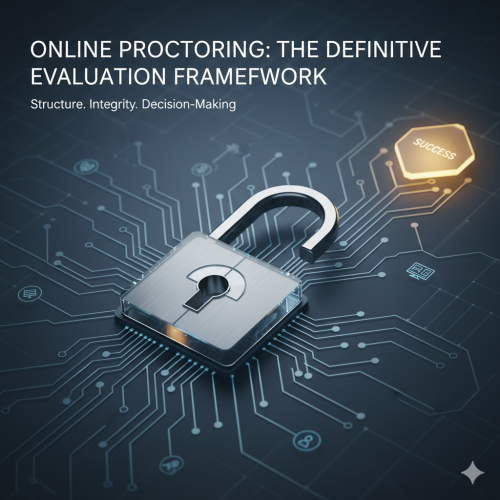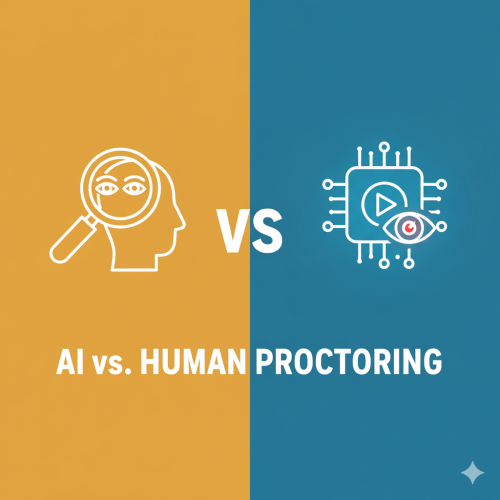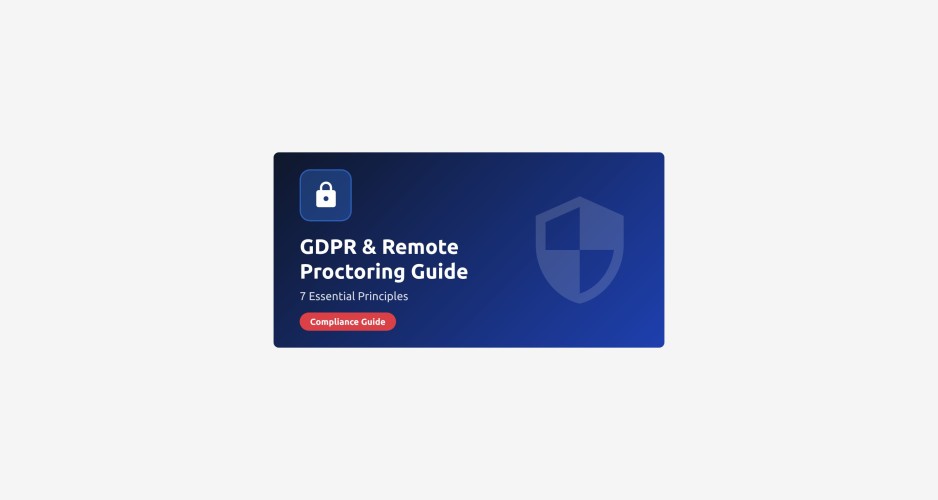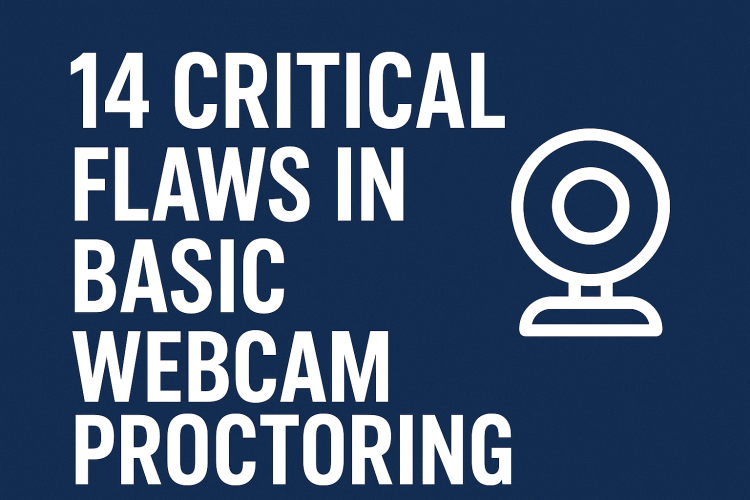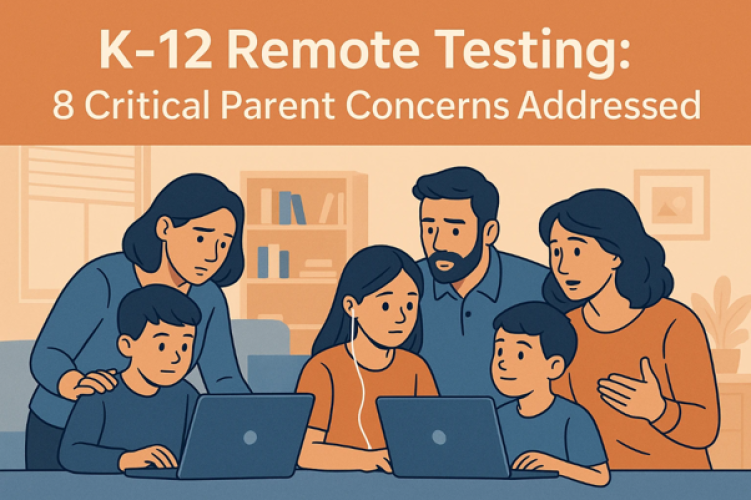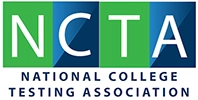Are you an EdTech institution or an online assessment company wondering how to keep your exams fair and secure? As more learning and certifications move online, ensuring exam integrity has become a major challenge. You need to stop cheating, but also provide a good experience for your candidates. This often comes down to choosing between two main methods: human proctoring or using AI remote proctoring technology, or perhaps a smart mix of both.
Making the right choice can seem complex. It affects your budget, how many exams you can run, and how candidates feel about your process. This guide will help you understand the core differences. We'll look at 12 critical pros and cons of both AI and human proctoring. Our goal is to give you a clear picture, helping you pick the best solution for your specific needs.
Understanding the Fundamentals: What Are They?
Before we dive into the comparison, let's first clarify what each type of proctoring involves.
Human Remote Proctoring
This is like having a supervisor in a physical exam hall, but done virtually. A real person, called a proctor, watches candidates through their webcam and microphone during an online exam. They can monitor one or several candidates at once. The proctor ensures candidates follow the rules, like not looking away or talking to others. They can also intervene directly if they suspect any unfair means.
What is AI Remote Proctoring?
AI remote proctoring uses special software to monitor exams. It doesn't use a human observer in real-time. Instead, artificial intelligence (AI) tools analyze the candidate's behavior. This includes tracking eye movements, detecting other faces in the room, checking for disallowed objects, and listening for unusual sounds. The AI software flags suspicious activities; these flags are then reviewed later by a human. This method brings automation to online assessment security.
The Hybrid Model
Many organizations are now looking at a hybrid approach. This model combines the best parts of both human and AI proctoring. AI tools continuously monitor the exam. If the AI flags anything, a human proctor then reviews the incident. Sometimes, a human might also join live for critical moments or for final approval. This offers a balance of efficiency and human judgment.
The 12 Critical Pros & Cons: AI vs. Human Proctoring
Let's compare these two methods across key areas that matter for your online assessments.
1. Scalability & Availability
AI Proctoring: This method allows you to monitor thousands of exams simultaneously. It works 24/7, making it ideal for candidates across different time zones or for large-scale tests like entrance exams. There are no limits based on a proctor's availability.
Human Proctoring: While useful for smaller groups, scaling human proctoring for very large numbers of candidates can be tough. You'll need to hire and train many proctors. This can be a logistical nightmare, especially if exams are global or happen during peak times.
2. Cost-Effectiveness
AI Proctoring: The initial investment for AI software can be high. However, for a large volume of exams, the per-exam cost usually becomes much lower in the long run. It reduces the need for constant human supervision, saving on salaries and training.
Human Proctoring: This method often has lower upfront costs. But the cost per exam can be higher, especially with proctor salaries, training, and overheads. These expenses add up significantly when you conduct many exams.
3. Accuracy & Detection
AI Proctoring: AI offers consistent and objective detection of unusual patterns. It uses algorithms to identify predefined cheating behaviors. However, it can sometimes flag innocent actions as suspicious, leading to what we call "false positives." For example,
imagine a candidate glancing at a reflection in their glasses—an AI might flag this, but a human could quickly see it's harmless.
Human Proctoring: You benefit from human proctors using their judgment to interpret situations. They can understand context better, which can reduce false positives. But human proctors can also make mistakes due to fatigue, distraction, or simply misinterpreting a situation.
4. Candidate Experience
AI Proctoring: Some candidates might find AI less intrusive because no one is watching them live. However, the idea of constant monitoring by a machine, including facial and gaze tracking, raises privacy concerns for others. Technical issues with the AI software can also frustrate candidates.
Human Proctoring: Many candidates prefer a human touch, finding it more reassuring to have someone available for questions or technical help during the exam. However, some might feel more nervous under live human surveillance. Also, proctors can sometimes be inconsistent in their approach.
5. Privacy & Data Security
AI Proctoring: This method involves collecting a lot of sensitive data, like biometric information (facial scans) and recordings of the candidate's environment. While data can be anonymized, managing this data securely and complying with global privacy laws like GDPR and CCPA is a big challenge.
Human Proctoring: Generally, human proctoring involves less data collection. It focuses more on direct interaction and visual observation. However, there's still a need for careful data handling of recordings, and human errors can lead to privacy breaches if not properly managed.
6. Intervention & Resolution
AI Proctoring: AI typically flags incidents for later review. It cannot have a real-time conversation or offer immediate help if a candidate has a genuine technical problem. This means issues are often addressed only after the exam ends.
Human Proctoring: A human proctor can intervene instantly if they see a problem. They can talk to the candidate, resolve minor issues, or even pause an exam. For example, if a candidate's screen freezes, a human proctor can guide them through a quick restart without
disrupting the flow. This real-time interaction provides comfort and quicker resolution during the test.
7. Bias & Fairness
AI Proctoring: Algorithms are designed to be consistent, which can reduce human bias. However, if the data used to train the AI has biases, the AI itself can become biased. For example, facial recognition might struggle with diverse skin tones, leading to unfair flagging.
Human Proctoring: Human proctors can sometimes have unconscious biases, leading to inconsistent treatment of candidates. They might unknowingly favor certain groups or misjudge others. Proper training is essential to minimize this.
8. Technological Requirements
AI remote proctoring software needs stable internet, a functional webcam, and specific computer hardware from the candidate's side. Your institution also needs robust systems to integrate the AI software with your Learning Management System (LMS) or assessment platform.
Human Proctoring: For candidates, the technical needs are often simpler, usually just a reliable internet connection and a webcam for video calls. For institutions, the main tech challenge is providing a stable platform for proctors to monitor.
9. Regulatory Compliance
AI Proctoring: Navigating the complex web of global privacy laws (like GDPR in Europe or India's upcoming data protection laws) for AI proctoring is tricky. Institutions must ensure full compliance regarding data collection, storage, and usage to avoid legal issues.
Human Proctoring: While still needing to follow privacy guidelines for recordings, the compliance burden is generally less complex. Fewer types of data are collected, simplifying data handling and privacy protocols.
10. Global Reach & Time Zones
AI Proctoring: This is a major advantage. AI systems can easily serve candidates worldwide, running exams at any time without needing proctors in specific time zones. This makes global expansion of online courses much easier.
Human Proctoring: Managing human proctors across many different time zones is a significant operational challenge. It requires careful scheduling and often means higher costs for staff working odd hours. This limits true global reach.
11. Cost of Errors/False Positives
AI Proctoring: When AI flags innocent actions, reviewing these false positives can be time consuming and costly. It can also lead to candidate appeals, delays in result declaration, and harm your institution's reputation. You'll need a clear process to handle these.
Human Proctoring: Human judgment can lead to fewer false positives initially. However, human errors can still occur, and training to reduce these mistakes is an ongoing cost. Mistakes by human proctors can also lead to similar appeals and reputation damage.
12. Adaptability & Flexibility
AI Proctoring: AI systems follow programmed rules. They are very consistent in applying these rules. However, they may struggle to interpret truly unique situations or unexpected candidate behaviors that are not part of their programming.
Human Proctoring: Human proctors can adapt to unique situations during an exam. They can use common sense and make on-the-spot judgments. This flexibility is valuable when unforeseen circumstances arise.
The Hybrid Proctoring Solution: Best of Both Worlds?
For many institutions, the ideal solution might not be one or the other, but a combination. Hybrid proctoring uses AI to monitor all candidates continuously; it efficiently flags any suspicious activities, leveraging the scalability of technology. Then, human proctors step in to review these specific flagged incidents.
This approach offers several advantages. You get the wide reach and cost efficiency of AI. At the same time, you retain the critical thinking, empathy, and nuanced judgment of human proctors. This can significantly reduce false positives, and it also allows for real-time human intervention when it truly matters.
Consider a hybrid model if you need high scalability but also want to ensure a fair, empathetic candidate experience and precise incident resolution. It helps balance security
with practicality for online assessment companies and EdTech institutions.
Practical Considerations for Implementation
Choosing a proctoring solution is a big decision. Here are some practical steps to consider for your institution:
Defining Your Needs: First, think about the type of exams you conduct. Are they high-stakes like professional certifications or university finals? Or are they lower stakes like quizzes? How many candidates do you have? What's your budget? Answering these questions will guide your choice.
LMS Integration: Ensure that your chosen proctoring solution integrates seamlessly with your existing Learning Management System (LMS) or assessment platform. A smooth integration means less hassle for your IT team and a better experience for candidates. Look for easy-to-use APIs and good technical support.
Data Privacy & Security: This is crucial. Understand all relevant data protection laws, including India's upcoming regulations, along with GDPR and CCPA if you have international candidates. Work with your legal team to ensure the proctoring solution meets all compliance standards. Ask vendors about their data storage, encryption, and anonymization practices.
Candidate Communication & Training: Transparency builds trust. Clearly communicate your proctoring policies to candidates well in advance. Explain how the system works, what data is collected, and how their privacy is protected. Provide simple guides or FAQs to help them prepare, reducing anxiety and technical issues during the exam.
Proctor Training (for hybrid models): If you opt for a hybrid model, invest in thorough training for your human proctors. They need to understand how the AI system works, how to review flagged incidents effectively, and how to intervene appropriately. This training ensures consistent application of rules and fair judgment.
Future Trends: What's Next for Proctoring?
The field of online proctoring is always evolving. We can expect even more advanced AI in the future. This includes AI that can detect emotions (with careful ethical considerations) or adaptive proctoring that changes based on the exam's difficulty or candidate's performance. Technologies like blockchain might also be used to secure certifications and verify their integrity, making them tamper-proof.
Ethical AI development will be a key focus. Companies will need to ensure AI systems are fair, transparent, and respectful of privacy. This will help build greater trust in online assessments. The future will likely see even smarter, more secure, and more user-friendly proctoring solutions.
Conclusion: Making an Informed Decision for Your Institution
Choosing between AI and human proctoring, or a hybrid approach, involves weighing many factors. Both have distinct advantages and disadvantages. AI offers unmatched scalability and cost efficiency for large volumes, while human proctoring provides empathy, real-time judgment, and nuanced intervention.
Your ultimate decision should align with your institution's core values, assessment goals, budget, and global reach. Carefully consider your exam integrity needs, candidate experience, and regulatory compliance requirements. The right proctoring solution will safeguard your assessments and enhance your reputation.
Ready to explore a proctoring solution tailored to your needs? Learn more about Proctor360's innovative approach.
Frequently Asked Questions
Q1: How can we minimize false positives and ensure a fair, unbiased assessment experience for all candidates, especially those with diverse backgrounds or technical challenges?
Minimizing false positives is a top concern. A hybrid proctoring model is often the best solution, where AI identifies potential issues, but a human then reviews these flags. This combines efficiency with human judgment, reducing incorrect accusations.
Also, ensure your chosen AI system is trained on diverse data sets to reduce inherent biases. Provide clear instructions and technical support to candidates before the exam. This helps them avoid accidental flags caused by technical difficulties or misunderstanding rules. Regular audits of flagged incidents can also help refine your proctoring process.
Q2: What are the precise regulatory and legal compliance requirements (e.g., GDPR, CCPA, India's data protection laws) we need to adhere to when deploying AI proctoring globally, and what are the specific risks if we don't?
Compliance is critical, especially with global reach. For India, keep an eye on new data protection laws. Internationally, GDPR (Europe) and CCPA (California, USA) are key examples. These laws dictate how you collect, store, and use personal data, including biometric information. Not complying can lead to huge fines, legal action, and severe damage to your reputation.
You must get explicit consent from candidates for data collection. Implement robust data encryption and secure storage practices. Regularly review your proctoring vendor's compliance certifications. It's always best to consult with legal counsel specializing in data privacy to ensure full adherence to all applicable laws.
Q3: Beyond just cost savings, what is the true ROI of investing in an AI proctoring solution compared to human proctoring, considering factors like scalability, efficiency, and improved data analytics?
The ROI of AI proctoring goes beyond just cutting per-exam costs. It allows for massive scalability, meaning you can conduct more exams without adding staff, opening new revenue streams. The automation significantly boosts operational efficiency, freeing up your team for other tasks.
AI solutions often provide rich data analytics. These insights can help you identify cheating trends, improve exam design, and refine your proctoring rules. This leads to better exam integrity and a stronger reputation, which are invaluable long-term benefits. These strategic advantages contribute significantly to your overall return on investment.
Q4: Our current LMS and assessment platforms are complex. How seamless is the integration process for AI proctoring, what technical expertise is required, and what common integration hurdles should we anticipate?
Integrating AI proctoring with existing complex LMS or assessment platforms can vary. Most modern AI proctoring solutions offer APIs (Application Programming Interfaces) for smoother integration. This means their system can "talk" to your existing platforms.
You will need some technical expertise, usually from your IT team or an integration specialist. Common hurdles include ensuring data synchronization, handling single sign-on (SSO), and testing compatibility across different browser versions. It's vital to choose a vendor with a strong track record of successful integrations and excellent technical support to guide you through the process.
Q5: Given the widespread concerns about privacy and surveillance, how can we effectively communicate the benefits and safeguards of AI proctoring to our candidates to build trust and ensure a positive perception of our assessment process?
Building candidate trust is crucial. Start with transparency: clearly state why proctoring is used (to ensure fairness for all) and how it works. Explain exactly what data is collected, how it's secured, and for how long it's stored. Emphasize that data is used only for exam integrity.
Provide accessible FAQs and pre-exam tutorials. Highlight that the AI helps detect anomalies, which are then reviewed by humans, not judged solely by a machine. This reassures candidates. Acknowledge privacy concerns directly and explain the safeguards in place, showing your institution's commitment to ethical practices.
